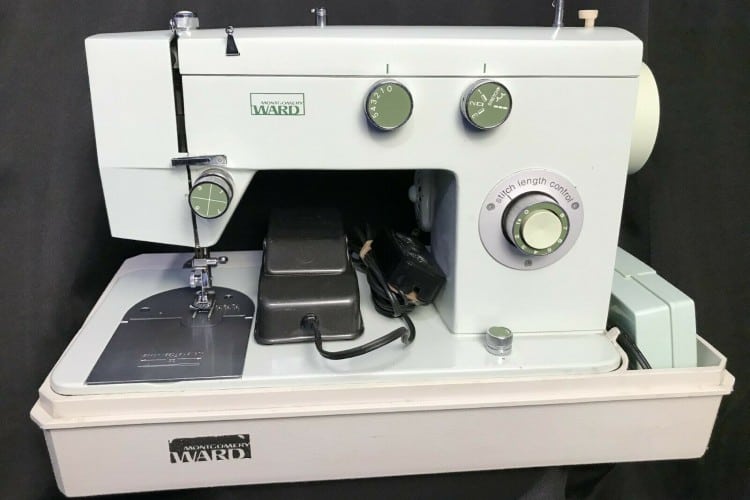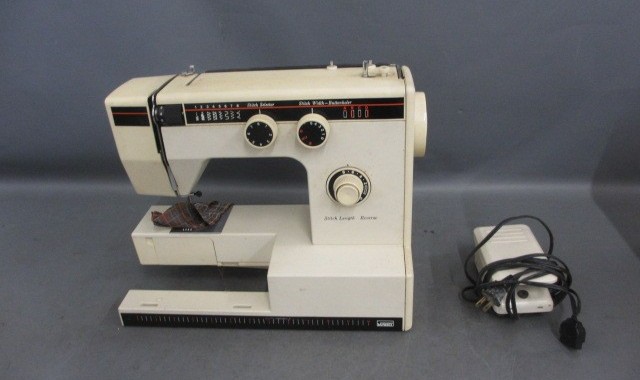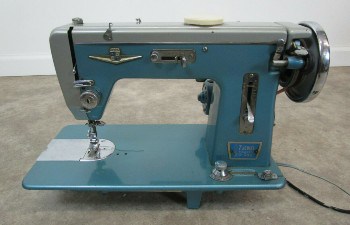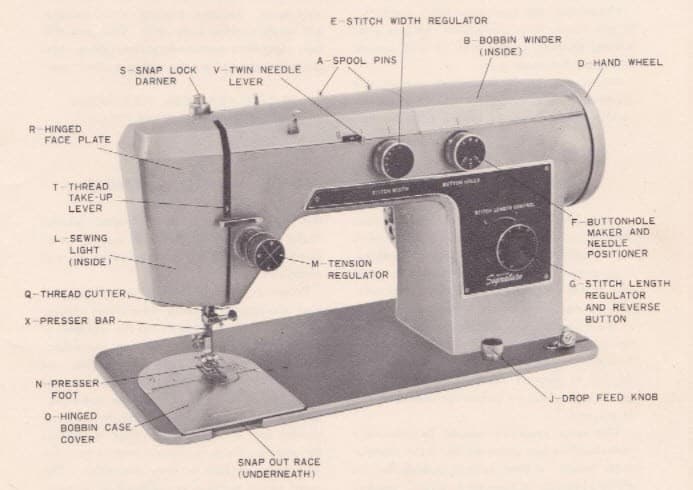Vintage sewing machines offer you impressive durability and the allure of historical charm. But you may find it challenging to pick the perfect vintage machine out of the wide range of options. What do you know about the Montgomery Ward sewing machine?
Montgomery Ward sewing machines sold from 1872-2001 and featured a variety of manufacturers. Today, home sewers value these vintage machines for their durable construction. Metal components and solid cases make vintage Montgomery Ward sewing machines reliable workhorses.
In this article, you’ll find a brief history of Montgomery Ward. You’ll also learn about their most popular models in a handy timeline. Finally, you will get a good idea of the typical value of these vintage machines.

Who Made Montgomery Ward Sewing Machines?
Montgomery Ward included sewing machines in its sales catalog for over a hundred years, but the company did not make any of these appliances. Instead, they re-branded and marketed products made by other manufacturers.
In 1872, Aaron Montgomery Ward published a one-page mail-order catalog for the rural area around Chicago. At this time, people who lived far away from metropolitan areas had no easy access to supplies. They either bought products from traveling salesmen or ventured into a city when they needed to make a purchase.
The mail-order catalog was the first of its kind and he faced some opposition early on. Despite this, his business expanded so fast that by 1883 the catalog reached an impressive 240-page length and encompassed more than 10,000 items. In fact, people started to call the catalog the “Wish Book!”
The 1890s saw the rise of Sears Roebuck. Sears launched its own mail-order catalog.
This led to many decades of competition between the two companies. In short order, they both grew to nationwide prominence.
Both companies offered sewing machines intended for home use. Today, it’s easy to see these as just one more item in a massive catalog of products. But in the early 20th century, the concept of owning a small domestic machine instead of sewing by hand was still quite novel!
In the early 1900s, Ward also built a vast chain of brick-and-mortar retail stores as they continued to expand their reach. Meanwhile, the catalog continued to grow dramatically through both world wars and the Great Depression.
It wasn’t until the development of suburbs and shopping malls in the 1950s that this retail giant finally began to topple. In 1985, the company closed down its famous catalog. And in the 1990s, it had to declare bankruptcy, largely due to competition from Walmart.
In the early 2000s, Swiss Colony bought what was left of Montgomery Ward and reinvented it as an online retailer. You can still purchase many items from their website today, though to date, the website does not offer any sewing appliances for sale.
Montgomery Ward Sewing Machine Timeline

Montgomery Ward sold “badged” sewing machines. This means that they bought and rebranded products manufactured by other companies. Manufacturing companies placed bids to win the right to make these appliances.
Foley and Williams manufactured the earliest models. The National Sewing Machine Company took over until the 1950s. During the 1950s, several Japanese companies such as the Happy Sewing Machine Company produced the machines.
In 1913, Ward launched a line of domestic machines made by Foley and Williams. They didn’t get great reviews even at the time. They were priced at under ten dollars (though in today’s currency, that would equal about $200).
Shortly after this, the contract switched over to the National Sewing Machine Company. National made almost all models produced before 1955.
Montgomery Ward continued to sell badged machines made by National through WWII. Following the war, international companies took over much of the industry.
The National Sewing Machine Company also got its start in the late 1800s. Based in Illinois, it had a successful run manufacturing bicycles and other home appliances. It built a fairly huge industry supplying badged products to Macy’s and Marshall Fields as well!
In 1955, Ward switched their contract to a Japanese manufacturer called Happy Sewing Machine Company. In the post-WWII era, Japan developed a massive sewing machine industry that crushed a lot of its American competition.
Called Happy Industrial Ltd. today, this company began producing sewing machines in 1945 and is still selling them now! They usually receive recognition as the best Montgomery Ward models.
Wards Signature Sewing Machine
 Ward marketed some of its Japanese-made models as its “signature” line. These products promoted special craftsmanship and high-quality parts.
Ward marketed some of its Japanese-made models as its “signature” line. These products promoted special craftsmanship and high-quality parts.
Most of these models made from the 1950s-1980s do feature solid metal components. But the concept of the special models didn’t get very far. Many early Japanese models made in this era just cloned the specs from older companies like Singer.
Despite that, the signature models do hold up well over time compared to other vintage models sold during this era.
It’s not always easy to track down the origins of a Montgomery Ward product, as you will find out shortly! That said, you can look for the designation of “JA” or just the letter “J” in front of the model number. This indicates that it was made in Japan.
For example, the Montgomery Ward sewing machine models made in 1954 include the 185A. You will find the phrase “made in Japan” stamped on these models. They feature solid metal construction, a lovely wooden cabinet, and a knee lever for control instead of a foot pedal or a treadle.
The J1984 also sold as part of the signature line. Made in Japan, it features a foot pedal, several decorative stitch options, solid metal parts, and rotary shuttle, and a free arm. It comes with a metal carrying case instead of the wooden cabinet of earlier years.
Home sewers value the J1984 because it runs more smoothly and quietly than many vintage models.
Montgomery Ward Sewing Machine Serial Numbers
All Montgomery Ward machines carry their brand name, and most of them also have a model and serial number. These numbers can help you find out who made it.
Model numbers describe a particular version of a product. This works like iPhones–the iPhone 7 is a different model from the iPhone 8, but Apple makes both.
A serial number is unique to one individual product. For this reason, it can sometimes help identify your appliance.
You can usually find these numbers in a couple of different places. Sometimes you can find it printed on the plastic case of your machine. Or you may find it stamped into a little metal label affixed to the body. Sometimes you may locate it stamped into the underside of the body.
Check the front of the casing, the right side above the power cord, and underneath the machine to locate these numbers.
Unfortunately, no one has compiled a registry of Montgomery Ward serial numbers or even a comprehensive list of all the model numbers produced. This means you may have trouble finding information online.
On top of that, some models may just feature the brand name and not even have a model number!
Some of the signature line models also have the word “Signature” printed somewhere on the body. If you find that and a serial number, you will be well on your way to finding more information about who made the signature machine!
Your best bet to identify your machine is probably to Google the model and serial number. Then scroll through Google images to find a picture that looks similar to yours!
How Old is My Montgomery Ward Sewing Machine?
Model and serial numbers can help you date antique and vintage Montgomery Ward machines. For many antique appliances, you can plug the serial number into Google and you will easily find helpful online registries that tell you when it was made. Unfortunately, this is not the case with Montgomery Ward.
That said, you can sometimes date an old Montgomery Ward machine in one of four ways. First, flip through the manual if you have it. This helpful booklet sometimes includes a manufacturing date.
If you don’t have your owner’s pamphlet, you may find a matching image if you search Google images. This will usually lead you to a blog or forum published by other sewing enthusiasts.
If that outlet failed, you may find a similar item on eBay if you search by your model number. Sometimes sellers will also publish helpful information in the product description.
Finally, if you really can’t find any information online, join a sewing or quilting discussion forum! Users commonly post questions about how to date vintage machines. They also share tips on how to repair and use these old appliances.
How Much is a Vintage Montgomery Ward Sewing Machine Worth?
The average price for a vintage Montgomery Ward sewing machine typically falls between $50-$200. The price depends heavily on the age and condition of its components such as a wooden cabinet or foot pedal. That said, even the signature models can price at as little as $100.
If you like to sew, you will probably value this vintage appliance for its sewing ability, not its monetary worth.
Whether or not it comes with all its original accessories such as various feet, cleaning apparatus, and a zigzag cam can also raise the price. Of course, whether or not the motor runs also makes a big difference!
So, are Montgomery Ward models good? Back in the day, they had a sort of Walmart appeal. The mail-order catalog made them accessible to everyone, and the low price outweighed the lack of quality.
Sewers today appreciate the Signature line for its reliability and solid metal construction. Despite that, you won’t find a lot of rave reviews about most of these models. For that reason, they don’t usually have a high price range.
In case you’re interested, most Montgomery Ward models fall into the vintage category. This period ranges from the early 1900s through about 1970. Any machines made before the 20th century would be classified as antique.
The National Sewing Machine Company that you read about earlier did sell various models that we would call antique today. These antiques can range in price from $50-$500, depending on the condition of the machine and its age and rarity.
If you plan to sell your grandmother’s old Montgomery Ward sewing machine, you probably can’t set the price any higher than about $100. Maybe you should keep her old machine and learn how to sew instead!
Tips for Using a Montgomery Ward Sewing Machine

Your best bet for finding information on an individual Montgomery Ward model is to check YouTube and to read the owner’s manual. As you search for information, make sure you put in your specific model number. This is important because each different model may operate differently.
Here are some general tips to get you started:
- First and most importantly, read the owner’s guide, if you can get your hands on it! This helpful pamphlet will give you set up and operating information.
- Check the condition of electric components such as the cord and the receptacle. One of the dangers of working with old appliances is that they may have frayed cords or even mysterious goop oozing near live electricity!
- To thread a vintage Montgomery Ward sewing machine, either read the owner’s manual for guidance or try following the visual cues on the machine to set up the thread path and thread the needle. Most vintage machines have a simple design that makes this doable. You can also sometimes find YouTube clips to get a visual guide for your particular model.
- To put a bobbin in a Montgomery Ward machine, you will need to place it on the winding lever and fill it with thread. Next, place it into the bobbin case, and slot the loose end of the thread through the provided hole in the case. Gently push the case into the machine and make sure you line up the little metal finger sticking off the case with the shuttle race notch that fits it like two puzzle pieces clicking together.
- If you run into trouble, always rethread the machine. Sometimes the thread slips out of the thread path as you sew. This can cause timing and tension issues. Rethreading will get you up and going again in no time!
- Finally, you don’t have to be an expert technician to clean your vintage machine. Open it up and use a small, soft brush to remove lint and dust. Oil metal portions carefully, according to the instructions in the owner’s manual.
Montgomery Ward Sewing Machine Owner’s Manual
A sewing machine owner’s manual provides essential information such as how to set up, clean, and use the machine. If you buy a new machine, you are guaranteed to receive this important document! Unfortunately, this isn’t always the case with vintage machines.
Some popular companies provide free downloadable manuals on their websites. Singer, for example, does a great job making old information easy to find.
Sadly, Montgomery Ward does not provide the same level of service. You can’t find any information on their website. In fact, the website does not even sell sewing appliances of any kind.
You can often find old copies of these manuals on eBay.
The bottom line is that it’s very challenging to find Montgomery Ward’s owner’s manuals today!
Montgomery Ward Sewing Machine Parts
You can usually find a good selection of different Montgomery Ward sewing machine parts for sale on eBay or websites such as this one. Whether you need a replacement motor or a zigzag cam, you can often find pieces more easily than you can find information on how to install them!
That said, easy access to replacement pieces does vary based on the age and rarity of your model. Because of this, you should factor in the condition of the machine before you buy it! You could end up spending a lot of time and money trying to make repairs if you buy a machine in poor condition.
That leads to another key question, which is, do you feel confident in your ability to repair a vintage machine? If not, you will want to make sure you can find a nearby technician before you go to all the trouble of ordering any replacement apparatus.
Vintage Singer vs Montgomery Ward Machines
Generally speaking, Singer ranks much more highly than Montgomery Ward. That said, comparing one model to another can feel like comparing apples and oranges because each one has its own unique features.
On the other hand, Singer made its name in the sewing business. Singer remains prominent in this industry today. While it might not class quite as highly as brands like Bernina or Brother, the brand name still means something.
Montgomery Ward sold pretty much everything under the sun, and sewing machines were only ever a small part of their business. Run-of-the-mill Montgomery Wards can also run very noisily. Some of them have prominent timing issues that impact the appearance of their stitching.
Does this mean that you should avoid this brand?
Not necessarily. If you can find one of the signature models in good working order, it will probably last many more years! The solid metal construction also makes these machines good at quilting and stitching through heavy woolens.
Of course, the condition, age, look, and rarity of any individual model matter as well. But generally, the vintage sewing machine world values Singers over Montgomery Ward machines.
Conclusion
Montgomery Ward launched the first mail-order catalog in the mid-1800s. They used this innovative marketing strategy to sell badged sewing machines over the next century.
Three main companies manufactured these machines. They include Foley and Williams, the National Sewing Machine Company, and Happy Industrial Ltd.
Have you ever owned a vintage Montgomery Ward? Leave a comment below to let us know if you liked it!
Beth Hope
Sunday 15th of August 2021
I love that the reconditioning demo is for my very own Montgomery Ward sewing machine! I love it. It is old and heavy but it is the one I bought when I was first married long long ago. I used it to make clothes for my 3 daughters over the years.
tks so much!
Beth